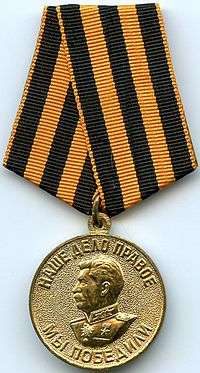Flag of Russia
 | |
| Name |
Триколор Trikolor Tricolor |
|---|---|
| Use | Civil and state flag, civil and state ensign |
| Proportion | 2:3 |
| Adopted |
11 May (29 April O.S.) 1696 (originally) 1700 (de facto for vessels) 1883 (de facto for land use) 12 August 1991 (as flag of the RSFSR) 11 December 1993 (current version) |
| Design | A horizontal tricolour of white, dark blue and red |
.svg.png) Variant flag of Russia | |
| Proportion | 2:3 |
The flag of Russia (Russian: Флаг России) is a tricolor flag consisting of three equal horizontal fields: white on the top, blue in the middle and red on the bottom. The flag was first used as an ensign for Russian merchant ships and became official as the flag of the Tsardom of Russia in 1696. It remained in use until the establishment of the Russian Socialist Federative Soviet Republic in 1917.
During the Soviet Union's existence, it used the flag with the red field with the golden hammer and sickle and the golden bordered red star on top. With the dissolution of the Soviet Union, the pre-revolutionary tricolor was re-introduced as the flag of the Russian Federation in 1991 in the 1:2 ratio. The Tsarist tricolor was fully restored in 1993 after the constitutional crisis as the current flag.
Origin
Two accounts of the flag's origin connect it to the tricolor used by the Dutch Republic (the flag of the Netherlands).[1][2]
The earliest mention of the flag occurs during the reign of Alexis I, in 1668, and is related to the construction of the first Russian naval ship, the frigate Oryol. According to one source, the ship's Dutch lead engineer Butler faced the need for the flag, and issued a request to the Boyar Duma, to "...ask His Royal Majesty as to which (as is the custom among other nations) flag shall be raised on the ship." The official response merely indicated that, as such issue is as yet unprecedented, even though the land forces do use (apparently different) flags, the tsar ordered that his (Butler's) opinion be sought about the matter, asking specifically as to the custom existing in his country.[3]
A different account traces the origins of the Russian flag to tsar Peter the Great's visits to Arkhangelsk in 1693 and 1694. Peter was keenly interested in shipbuilding in the European style, different from the barges ordinarily used in Russia at the time. In 1693, Peter had ordered a Dutch-built frigate from Amsterdam. In 1694 when it arrived, the Dutch red-white-and-blue banner flew from its stern.[4] Peter decided to model Russia's naval flag after this banner by changing the sequence of colors.
The Dutch flag book of 1695 by Carel Allard, printed only a year after Peter's trip to Western Europe, describes the tricolor with a double-headed eagle bearing a shield on its breast, and wearing a golden crown over both of its heads.
History
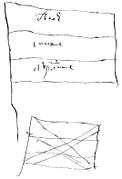
by Peter the Great, 1699

before and after 1896
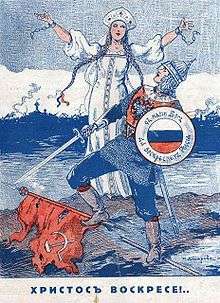
propaganda poster, 1932
.jpg)
Liberation Army of 1944–45

flag during the August Coup, 1991
After the freeing of Kievan Rus from the Mongols during the reign of Ivan III of Russia the dark red color of the Moscow kingdom changed to the red color of the Moscow state, a change which was expressed in the use of the red color for the seal of sovereign letters and in the color of the sovereign banner.[5]
Flags of the Tsardom of Russia & the Russian Empire
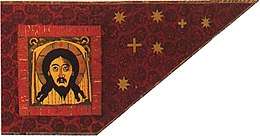
In 1552, Russian regiments marched on the victorious assault of Kazan under Ivan the Terrible with the banner of the "Most Gracious Savior". For the next century and a half, the banner of Ivan the Terrible accompanied the Russian army. Under Tsarina Sophia Alekseevna, it visited the Crimean campaigns, and under Peter the Great, the Azov campaigns and the Russo-Swedish War.
In the Illustrated Chronicle of Ivan the Terrible, there is an image of the banner of Ivan the Terrible in the Kazan campaign — a bifurcated white one with the image of the Savior and an eight-pointed cross above it. According to other sources, the banner was red instead of white. A copy of this banner, which has been restored many times, is still kept in the Kremlin Armoury.
In 1612, the Nizhny Novgorod militia raised the banner of Dmitry Pozharsky. It was crimson in color with the image of the Lord Almighty on one side and the archangel Michael on the other.
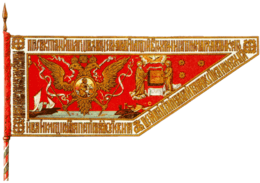
In 1669, the Polish painters Stanislav Loputsky and Ivan Mirovsky invited by Tsar Alexis of Russia, painted for the tsar's palace in Kolomenskoye "the hallmarks (that is, the emblems) of the sovereigns and all the universal states of this world." Then Loputsky drew "on the canvas, the coat of arms of the Moscow State and the arms of other neighboring countries, under every emblem of the planet under which they are." The coat of arms was a white rectangular banner with a "slope" and a wide red border, in the center of which was depicted a gold two-headed eagle and the emblems symbolizing the subject kingdoms, principalities and lands. In the inventory of the Kremlin Armoury, the coat of arms is described as the following: "In the circle there is a two-headed eagle wearing two crowns, and in his chest, the king on horseback pricks a serpent with his spear".[6]
On August 6, 1693, during Peter the Great's sailing in the White Sea with a detachment of warships built in Arkhangelsk, the so-called "flag of the Tsar of Moscow"[7] was raised for the first time on the 12-gun yacht "Saint Peter". The flag was a cross-stitch of 4.6x4.9 meters sewn from cloth, composed of three equal-sized horizontal stripes of white, blue and red, with a golden double-headed eagle in the middle.[8] The original of this oldest surviving Russian flag is located in the Central Naval Museum in Saint Petersburg.
The 1695 flag book by Carel Allard describes three flags used by the tsar of Muscovy: The tricolour with the double-headed eagle bearing a shield on its breast and wearing a golden crown over both of its heads, the tricolour with a blue saltire over it, and a third showing red and white quartering with a blue cross over all.[9]
The armorial flag of Peter the Great was created in 1696. Made from red taffeta with a white border, the flag depicted a golden eagle hovering over the sea. On the chest of the eagle in the circle is the Savior, next to the Holy Spirit and the holy apostles Peter and Paul. The banner was likely made for the second Azov campaign.[10]
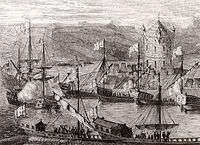
In 1693, Franz Timmerman received the order to build merchant ships in Arkhangelsk and trade with Europe. He was told to display the two-headed eagle spread with wings, with three crowns over it. On the chest of the eagle, a warrior on horseback was to be displayed with a spear, in a military harness. The same eagle was also to hold a sceptre with the right leg and an apple with a crest with the left. The same instructions were given to other traders.[11]
According to Dutch newspapers, in June 1694, a 44-gun frigate bought by Russia and built in Rotterdam stood in the Amsterdam roadstead under the white-blue-red flag.[12]
In 1696, at the mouth of the river Don, a Russian flotilla of armed rowboats blocked the supply of the Ottoman fortress of Azov. On the 1700 engraving by Adrian Shkhonebek, Taking the fortress of Azov. 1696, depicts the ships carrying rectangular panels on the flagpoles, the heraldic shading of which shows that some of the flags are blue with a straight red cross, and the rest are white with a straight red cross. A number of researchers doubt the accuracy of Shkonebek's engraving because he was not a witness to the events.[13]
Images of various white-blue-red Russian flags are present in the three later paintings of Abraham Storck's workshop dedicated to the arrival in Amsterdam of Peter I. Peter I took part in a practice battle on the river IJ while on board the yacht of the Dutch East India Company.[14] In the paintings of Abraham Stork depicting the show fight, this yacht sails under the white-blue-red flag with a double-headed eagle, or under a white-red-blue pennant and a white-red-blue aft flag with a double-headed eagle.
In October 1699, Peter I, on the back of the sheet with instructions sent to the Russian envoy Yemelyan Ukraintsev in Istanbul, drew a sketch of a three-band white-blue-red flag.[15]
In December 1699, the Austrian ambassador Anton Paleyer gave a list of weapons and flags seen on the vessels of the Azov Flotilla in a letter. He described seeing three small flags of white-red-blue colors and two regimental colors of red and white mixed in with other colors.[16]
In April 1700, Peter I ordered the Kremlin Armoury to build white-red-violet sea banners.[17] The design and dimensions of these banners correspond to the figure and the size of the regimental banner kept among the other 352 trophy Russian banners in the burial vault of Swedish kings - the Riddarholm Church in Stockholm.[18]
The three-band white-blue-red flag, as well as the flag with a red Jerusalem cross, were also used on warships up to 1720 as signals.[19]
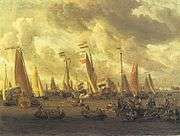

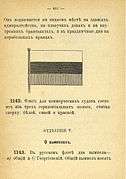
The Russian tricolour flag was adopted as a merchant flag at rivers in 1705. The choice of colors is significant in that they represent in order of priority, white for God, Blue for king and Red for people and/or country. These colors of the flag of Russia inspired the choice of the "Pan-Slavic colours" by the Prague Slavic Congress, 1848. Two other Slavic countries, Slovakia and Slovenia, have flags similar to the Russian one, but with added coats-of-arms for differentiation. On 7 May 1883, the Russian flag was authorized to be used on land, and it became an official National flag before the coronation of Tsar Nicholas II in 1896.
The flag continued to be used by the Russian Provisional Government after the Tsar was toppled in the February Revolution and was not replaced until the October Revolution which established the Russian Socialist Federative Soviet Republic.
Flags of the RSFSR
.svg.png)
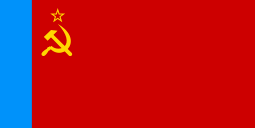
On 8 April 1918, the flag of the Russian Soviet Federative Socialist Republic was discussed at a meeting of the Council of People's Commissars of the RSFSR. The Council proposed that the All-Russian Central Executive Committee create a red flag with the abbreviation for the phrase Workers of the world, unite! However, the proposal was not adopted. On 13 April 1918, the All-Russian Central Executive Committee established the RSFSR flag to be a red banner with the inscription Russian Socialist Federative Soviet Republic. The text of the decree did not contain any clarification regarding the color, size and location of the inscription, or the width and length ratio of the cloth.
On 17 June 1918, the All-Russian Central Executive Committee approved a sample image of the flag of the RSFSR, developed on behalf of the People's Commissariat for Foreign Affairs of the Russian SFSR by the graphic artist Sergey Chekhonin. The flag was a red rectangular panel, in the upper corner of which was placed the inscription RSFSR in gold letters stylized as Slavic. This inscription was separated from the rest of the cloth on both sides by gold stripes forming a rectangle.
On 30 December 1922, the RSFSR combined with the Ukrainian SSR, Byelorussian SSR, and Transcaucasian SFSR to form the Soviet Union. The national flag of the USSR was established on 18 April 1924, described in the Constitution of the USSR as a red or scarlet rectangular cloth with a 1:2 width to length ratio, with a gold sickle and hammer in the top corner next to the flagpole and a red five-pointed star framed with a golden border. This flag was carried by all ships of the USSR and diplomatic representations of the USSR. The 1:2 red flag was used, until replaced in 1954 with the universal design of the Soviet flag with a blue stripe along the mast.
Contrary to the belief that the USSR state flag outranked the flag of the RSFSR, the actual use of the USSR flag was limited. The USSR flag in Russia flew only over two buildings, that of the Central Executive Committee of the Soviet Union and the Council of People's Commissars. That decision was adopted on 23 March 1925, also establishing that the flag of the RSFSR had to be raised constantly not only on the buildings of the Central Executive Committee and the Council of People's Commissars but also on the buildings of all local soviets, including village soviets and district soviets in cities. On holidays, the RSFSR flag had to be raised on many public buildings (such as schools, hospitals, and government offices).[21]
During the Second World War the white-blue-red tricolor has been used by the collaborationist anti-Stalinist troops of Andrey Vlasov, who was allied with Nazi Germany against the Soviet Union.[22][23]
On January 20, 1947, the Presidium of the Supreme Soviet of the USSR found it necessary to amend the national flags of the allied republics so that the flags reflected the idea of a Soviet Union state as well as the unique national identities of the republics. On each of the flags was placed the emblem of the USSR, a sickle and a hammer with a red five-pointed star, with the inclusion of national ornaments and new colors.[24] The new RSFSR flag was established in January 1954: a red rectangular panel with a light blue strip near the pole running the full width of the flag. In the upper left corner of the red canvas were depicted a golden sickle and a hammer and above them a red five-pointed star framed with a golden border. By the Law of the RSFSR of 2 June 1954, this flag was approved and the description of the flag was included in Article 149 of the Constitution of the RSFSR [25]
Flags of the Russian Federation
.svg.png)
It was not until the dissolution of the Soviet Union in 1991 that the tricolor was brought back as the official flag of the new Russian Federation. Following the events of the attempted coup in Moscow, the supreme soviet of the Russian SFSR declared, by resolution dated 22 August 1991,[26] that the old imperial tricolor flag serve as the national flag of the state. The constitution was subsequently amended by Law No. 1827-1 of November 1, 1991.[27]
The modern era flag underwent a proportion change from 1:2 to 2:3 in 1993 and has been most recently provided for by a 2000 law.[28] On December 11, 1993, President of the Russian Federation Boris Yeltsin signed Decree No. 2126 "On the State Flag of the Russian Federation".[29] In Article 1 of the decree, the flag was described as a "rectangular panel of three equal horizontal stripes: the top - white, middle - blue, and bottom - red, with a width to length ratio of 2:3."
The National Flag Day is an official holiday in Russia, established in 1994. It is celebrated on 22 August, the day of the victory over putschists in 1991, but employees remain at work.
Symbolism
There are varying interpretations as of to what the colors on the Russian flag mean. The most popular is as follows: The white color symbolizes nobility and frankness, the blue for faithfulness, honesty, impeccability and chastity, and red for courage, generosity and love.[30]
Color specifications
Federal constitutional law of the Russian Federation only says that the colors of the flag are "white", "dark blue" and "red". It does not specify the exact colors of the flag. In practice, however, federal authorities usually use the following colors:
| Scheme | White | Dark blue | Red |
|---|---|---|---|
| Pantone | White | 286C | 485C |
| RGB | 255-255-255 (#ffffff) | 0-57-166 (#0039a6)[31] | 213-43-30 (#d52b1e)[32] |
| HTML | #FFFFFF | #0039A6 | #D52B1E |
Variant versions
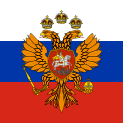

A variant of the flag was authorized for private use by Tsar Nicholas II before World War I, adding the large state eagle on a yellow field (imperial standard) in a canton in the top left-hand corner. It was never made the official state flag.
When the Bolsheviks took power in 1917, the tricolor design was discarded, and a definitive new flag of the SFSR (one of the constituent republics of the Soviet Union) was introduced in 1954 (see flag of Russian SFSR), and this remained the republic's flag until the collapse of the Soviet Union in 1991. All of the Soviet Republics' flags were created by introducing a small but noticeable change to the flag of the Soviet Union. For Russia, the change was an introduction of the left-hand blue band. The previous Soviet design was different, a plain red flag with different variants of the "RSFSR" abbreviation in the canton. Today, the Soviet flag is used by the supporters and members of the Communist Party of the Russian Federation.
The tricolor was used by the anticommunist forces during the Civil War called the White movement. It was continued to be used by White émigrés in various countries as the Russian flag. The tricolor was associated both in Soviet Russia as well as the Russian White emigre communities as symbolizing a traditional tsarist Orthodox Russia. It, as well as the naval ensign of the Imperial Russian Navy was used by anticommunist Russian troops under German command during the Second World War. Both flags can be seen inside a few Orthodox churches in the West established by the Russian communities. In the Soviet Union, this flag was used in films set in the prerevolutionary period and was seen as an historical flag, especially after the 1940s.
It, rather than the black-yellow-white color combination, was readopted by Russia on 22 August 1991. That date is celebrated yearly as the national flag day.
The President of Russia uses a Presidential Standard (Russian: Штандарт Президента), which, since 1994, is officially defined as the tricolor with the coat of arms (at this case the two-headed eagle is depicted without the shield) in the middle.[33]
On the standard (flag) of the President of the Russian Federation Entered into force on February 22, 1994 pravo.gov.ru
During the annual Victory Day celebrations in Moscow, a variant of the Soviet flag that was used during the raising a flag over the Reichstag has the grey hammer and sickle, referred to as the Victory Banner. Under the presidency of Boris Yeltsin, an earlier version of the Victory Banner was red with just a golden star on the top.
The Flag of Russia is represented as the Unicode emoji sequence U+1F1F7 🇷 REGIONAL INDICATOR R and U+1F1FA 🇺 REGIONAL INDICATOR U.[34]
Military flags
St. Andrew's flag (Russian: Андреевский флаг, tr. Andreyevsky flag) has a white background with two blue diagonal bands, forming a saltire cross associated with St. Andrew. The ratio of the flag's width to its length is 2:3, the width of the blue band is 1⁄10 the length of the flag.[35]
|
|
|
|
|
|
|
Historical flags
|
|
|
|
|
|
|
|
Gallery
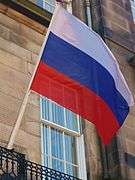 The tricolor at Russian Consulate-General in Edinburgh
The tricolor at Russian Consulate-General in Edinburgh The tricolor and the Banner of Victory on the 2009 Moscow Victory Day Parade
The tricolor and the Banner of Victory on the 2009 Moscow Victory Day Parade- Football fans with a gigantic Go Russia! banner, featuring the Russian Bear on the foreground of the tricolor

 Beriev Be-200 dropping water painted into the national colors at the 2009 MAKS Airshow
Beriev Be-200 dropping water painted into the national colors at the 2009 MAKS Airshow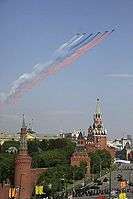 The flag in the sky over the Moscow Kremlin on the 2010 Moscow Victory Day Parade
The flag in the sky over the Moscow Kremlin on the 2010 Moscow Victory Day Parade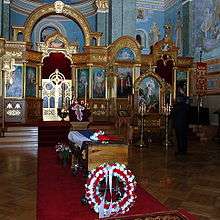 Flag over coffin of Anton Denikin in New York City, this was used as the Russian flag by White émigrés abroad during the Soviet period.
Flag over coffin of Anton Denikin in New York City, this was used as the Russian flag by White émigrés abroad during the Soviet period.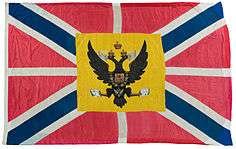 Russian naval flag of the 74-gun ship Vladislav captured at the battle of Hogland in 1788
Russian naval flag of the 74-gun ship Vladislav captured at the battle of Hogland in 1788 Tricolor flag hanging in a ceiling of a local high school in Toronto, Canada as part of an international flag display.
Tricolor flag hanging in a ceiling of a local high school in Toronto, Canada as part of an international flag display. Russian flag in Peterhof
Russian flag in Peterhof
See also
References
- ↑ Hulme, Frederick Edward (1897-01-01). The Flags of the World: Their History, Blazonry and Associations. Library of Alexandria. ISBN 9781465543110.
- ↑ Greenway, H. D. S. (2014-08-19). Foreign Correspondent: A Memoir. Simon and Schuster. p. 228. ISBN 9781476761329.
- ↑ Flag T.H. Eriksen & R. Jenkins, Nation and Symbolism in Europe and America. Abingdon, 2007, p. 23
- ↑ Robert K. Massie, Peter the Great, 160 (Modern Library Edition 2012)
- ↑ Самоквасов Д. Я. К вопросу о государственных цветах древней России. — М.: тип. Саблина, 1910. — 16 с.
- ↑ "Государственная символика" (in Russian). Archived from the original on 30 June 2013. Retrieved 29 June 2013.
- ↑ Центральный военно-морской музей. Список экспонатов музея. Флаг царя Московского.
- ↑ Белавенец П. И. Флаг Царя Московского, хранившийся в кафедральном соборе города Архангельска с 1693 года / Бюллетень Управления геральдики Государственной архивной службы Российской Федерации. Вып. № 1, октябрь 1993 г., — С. 3
- ↑ Russian flags at Flags of the World
- ↑ Н. А. Соболева, В. А. Артамонов (1993). Символы России (in Russian). Панорама. p. 208. ISBN 5-85220-155-3.
- ↑ Елагин С. Наши флаги. / Морской сборник, т. LXVIII, 1863, № 10 — С. 231
- ↑ Басов А. Н. История военно-морских флагов. — М.: Аст, СПб.: Полигон, 2004, ISBN 5-17-022747-7, С.46
- ↑ Оленин Р. М., Карманов В. В. От первого корабля до первого Устава. История морских флагов России (1669—1725 гг.). — СПб.: «Шатон», 2006. — С. 54
- ↑ Uiterst links een jacht met de Russische vlag en tsaar Peter de Grote aan boord, gekleed in het rood (Слева — яхта под флагом России с царём Петром I на борту, одетым в красное). Het Spiegelgevecht op het IJ ter ere van het Moskovisch gezantschap (1 september 1697), 1697—1700
- ↑ Устрялов Н. Г. История царствования Петра Великого. Т. IV. — СПб., 1863. Карты, планы и схемы. — С. 15 (копия листа с приложения № 14)
- ↑ Елагин С. И. История русского флота. Период Азовский. Приложения. Ч. 1. — СПб., 1864 — С. 428—429
- ↑ Яковлев Л.П. (1865). Древности Российскаго государства, изданныя по высочайшему повелению. Доп. к 3 отд-нию: Русския старинныя знамена. М. p. 110.
- ↑ П. И. Белавенец. Краткая записка о старых русских знамёнах. — СПб, 1911. С.33
- ↑ Оленин Р. М., Карманов В. В. От первого корабля до первого Устава. История морских флагов России (1669—1725 гг.). — СПб.: «Шатон», 2006. — С. 207
- ↑ Het Spiegelgevecht op het IJ ter ere van het Moskovisch gezantschap (1 september 1697), 1697—1700
- ↑ Собрание узаконений и распоряжений правительства РСФСР. — 1925, № 20, цит. по: Вексиллологический справочник по флагам Российской Империи и СССР, Т.1/сост. Соколов В. А. — М.: МГИУ, 2002, ISBN 5-276-00240-1, СС.487-488
- ↑ Lilia Shevtsova: Putin's Russia. Carnegie Endowment, 2010. p. 114
- ↑ Kathleen E. Smith: Mythmaking in the New Russia: Politics and Memory During the Yeltsin Era. Cornell University Press, 2002. p. 160
- ↑ Центральный Государственный архив Киргизской ССР, ф.1445, оп.3, д.29, л.2, цит. по: Вексиллологический справочник по флагам Российской Империи и СССР, Т.1/сост. Соколов В. А. — М.: МГИУ, 2002, ISBN 5-276-00240-1, СС.399-400
- ↑ Закон РСФСР от 2 июня 1954 г. «О Государственном флаге РСФСР»
- ↑ per Resolution No. 1627/1-I of the Supreme Soviet of the RSFSR of August 22, 1991
- ↑ per Law No. 1827-1 of the RSFSR of 1 November 1991
- ↑ per Decree No. 2126 of 11 December 1993
- ↑ О Государственном флаге Российской Федерации : Указ Президента РФ от 11.12.1993 № 2126 // Собрание актов Президента и Правительства Российской Федерации. 1993. № 51. Ст. 4928.
- ↑ Государственный флаг России. Статья на сайте Политического консультативного центра
- ↑ Pantone 286 C
- ↑ Pantone 485 C
- ↑ per Decree No. 319 of 15 February 1994
- ↑ "🇷🇺 Flag for Russia Emoji". Retrieved 2018-01-02.
- ↑ Whitney., Smith, (1975). Flags through the ages and across the world. New York: McGraw-Hill. ISBN 9780070590939. OCLC 1324552.
The black-orange-white flag was very unpopular, so much so that the government felt compelled on 7 May 1883 to recognize the white-blue-red as official for use on land during celebrations. Hence the flag intended for unrestricted use was rarely seen in prerevolutionary Russia, while the flag restricted to special occasions was in fact the most likely to be hoisted whenever private citizens wished to express their nationality by displaying a flag on land.
- ↑ Whitney., Smith, (1975). Flags through the ages and across the world. New York: McGraw-Hill. ISBN 9780070590939. OCLC 1324552.
The black-orange-white flag was very unpopular, so much so that the government felt compelled on 7 May 1883 to recognize the white-blue-red as official for use on land during celebrations. Hence the flag intended for unrestricted use was rarely seen in prerevolutionary Russia, while the flag restricted to special occasions was in fact the most likely to be hoisted whenever private citizens wished to express their nationality by displaying a flag on land.
- ↑ Currently being used by ultra-nationalists and monarchists
- ↑ Whitney., Smith, (1975). Flags through the ages and across the world. New York: McGraw-Hill. ISBN 9780070590939. OCLC 1324552.
The black-orange-white flag was very unpopular, so much so that the government felt compelled on 7 May 1883 to recognize the white-blue-red as official for use on land during celebrations. Hence the flag intended for unrestricted use was rarely seen in prerevolutionary Russia, while the flag restricted to special occasions was in fact the most likely to be hoisted whenever private citizens wished to express their nationality by displaying a flag on land.
- ↑ Currently being used by ultra-nationalists and monarchists
- ↑ Resolution of the Supreme Soviet of the Russian SFSR from 22 August 1991 "On the national flag of the Russian SFSR"
- ↑ Law "On Amendments and Additions to the Constitution (Basic Law) of the Russian SFSR" from 1 November 1991
- ↑ Resolution of the Supreme Soviet of the Russian SFSR from 22 August 1991 "On the national flag of the Russian SFSR"
- ↑ Law "On Amendments and Additions to the Constitution (Basic Law) of the Russian SFSR" from 1 November 1991
External links
| Wikimedia Commons has media related to Flags of Russia. |
- Official image of the Russian flag, on the official site of the Russian President.
- Federal Constitutional Law of December 25, 2000 No. 1-FKZ "On the State Flag of the Russian Federation" (including amendments). pravo.gov.ru (in Russian)
- Timeline Russian National Flag.(in Italian)
- Flag of Russia - old link(in Russian)
- Flag of Russia - Vexillographia(in Russian)
- Flag of Russia(in Russian)
- National Flag and Naval Ensign in Russia Navy.(in Russian)
.svg.png)

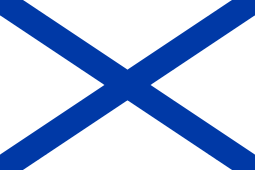
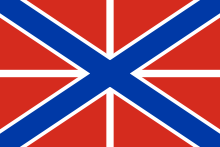

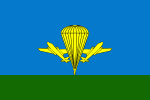
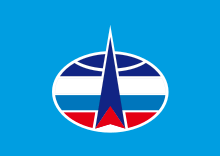
.svg.png)
.svg.png)
.svg.png)
.svg.png)
.svg.png)


